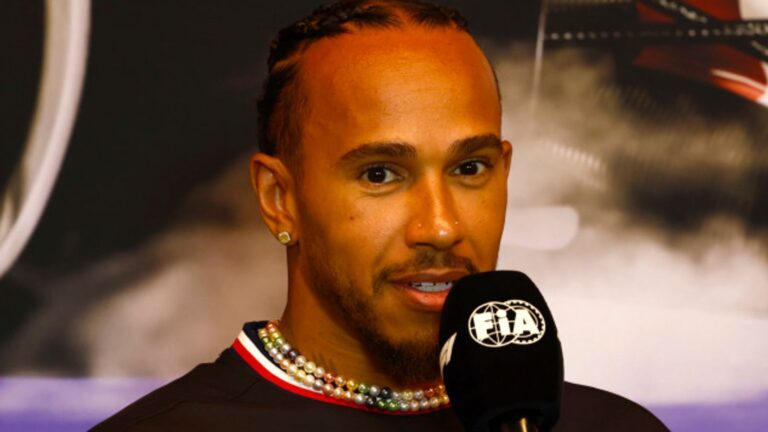Lewis Hamilton was among many Formula One drivers to express concern about the potential lack of speed in the sport’s cars in 2026 after new regulations were revealed on Thursday.
The sport’s governing body, the FIA, has published regulations that will dictate the design of the next generation of F1 cars, with a focus on downsizing current models to produce tighter races .
The smaller machines will see the weight of F1 cars reduced by 30 kilograms, while also incorporating a simplified combustion engine using fully sustainable fuels and the introduction of a new overtaking throttle button.
Seven-time world champion Hamilton, who will drive for Ferrari when the new rules are introduced in 2026, said: “He only weighs 30kg, so although it’s a step in the right direction, they’re still heavy.”
“I just saw what everyone saw this morning so I don’t really have any thoughts on that yet.
“I’ve spoken to some drivers who have driven (the 2026 car) on the simulator and they say it’s quite slow. So we’ll see if it’s actually the right direction or not.”
“But I think in terms of sustainability, especially on the powertrain side, I think it’s a really bold step and it’s going in the right direction.
“But we just need to make sure the cars are efficient, fast and a real step forward, and that the racing is actually improved.”
Albon: I think 2026 cars will be extremely slow
With the release of the regulations ahead of the media day preceding the Canadian Grand Prix this weekend, several drivers had the opportunity to give their reactions.
Some drivers have had the opportunity to drive simulated versions of the 2026 cars, and rumors of unconvincing performance appear to have spread around the paddock.
Williams driver Alex Albon, who recently signed a long-term contract with the team, was perhaps the most candid of the current drivers when giving his assessment.
“I don’t want to speak out of turn but I think it’s going to be very slow, extremely slow,” Albon said. “I guess there’s a lot of stuff that’s being done to make sure the straight-line speeds don’t drop off at the end with all the MGU-K and everything else involved.
“I still think there’s work to be done. Considering the work we’ve done and the speed marks around some of the tracks, it’s quite slow.”
The size of the cars, I think, is the right direction. Without speaking negatively about it, I think there are positives and negatives to all of this. It seems that recovering what the new engine regulations create means that everything becomes extremely complicated.
“In the whole aerodynamic path that we’re going to go down, I’d rather just have a little bit simpler engines, a little more parts maybe standardized in the engines or whatever, and just go back to more basic regulations.” .
Alonso: Close competition is most important
Aston Martin’s Fernando Alonso, the only driver older than Hamilton on the grid, who also signed a deal to continue driving under the new regulations, said the most important factor will be competitiveness.
“I think the smaller cars, just being able to overtake or fight a little more, that will be the best part for the drivers,” said the Spaniard.
“I think for us the most important thing is that it’s a close competition and many teams and drivers have the opportunity to win. What we don’t like is when one team wins every races for two or three years, so let’s see if the 2026 rules can provide that.
The new regulations tended to produce a dominant car for a significant period, before rivals began to catch up, as is the case in the current campaign, with Red Bull’s Max Verstappen eventually coming under pressure from Ferrari and McLaren after two dominant campaigns.
However, maintaining the same regulations for extended periods of time would go against the essence of the sport and the cutting-edge design and technology created by its engineers.
“More often than not, when they (the FIA) make changes, some teams do better than others,” Hamilton added.
“I hope these regulations don’t make too much of a difference.”
McLaren’s Oscar Piastri has echoed fears the peloton could expand again with a change in regulations.
“Every time the regulations have changed it has led to quite a significant spread,” the Australian said.
“With these regulations we are just starting to catch up with Red Bull.
“But we have the place in society to be at the forefront of technology and innovation and I guess you could say that sometimes that comes at the expense of racing.
“I wouldn’t be surprised if the teams split further in 2026 with the aerodynamic and engine regulations.”
Canadian GP live schedule from Sky Sports F1
Friday June 7
6 p.m.: First practice of Canadian general practitioners (session starts at 6:30 p.m.)
8 p.m.: The F1 Show
9:45 p.m.: Practice 2 of the Canadian GP (the session starts at 10 p.m.)
Saturday June 8
5:15 p.m.: Practice 3 of the Canadian GP (the session starts at 5:30 p.m.)
8 p.m.: preparation for qualifying for the Canadian GP
9 p.m.: Canadian GP qualifying
11 p.m.: Ted’s qualification log
Sunday June 9
5:30 p.m.: Grand Prix Sunday – Preparation for the Canadian GP
7 p.m.: THE CANADIAN GRAND PRIX
9 p.m.: Checkered flag – Reaction from the Canadian GP
10 p.m.: Ted’s notebook
Formula 1 leaves Europe for the last time before the summer holidays as the championship moves to Montreal for the Canadian Grand Prix. Watch every session at Circuit Gilles Villeneuve this weekend live on Sky Sports F1, with the Sunday race at 7pm. Stream every F1 race and more with a NOW Sports Month subscription – No contracts, cancel anytime





